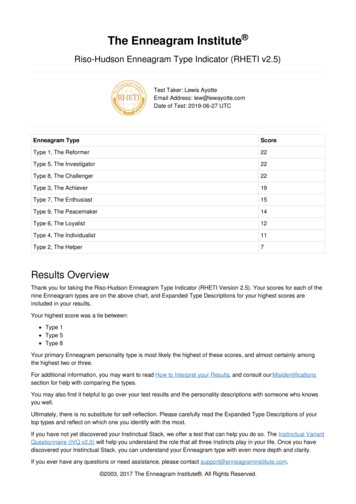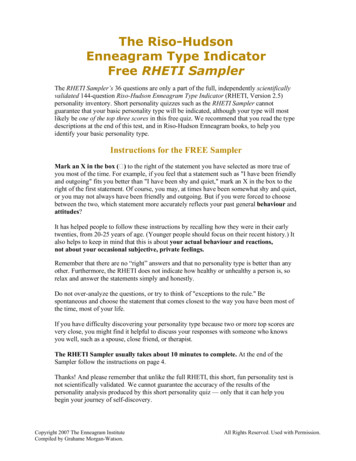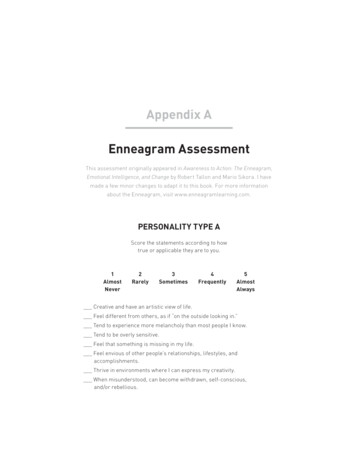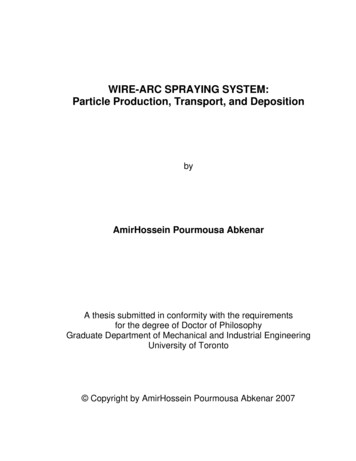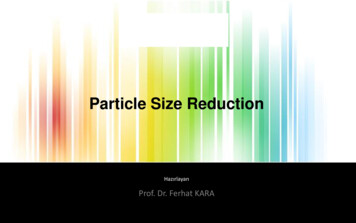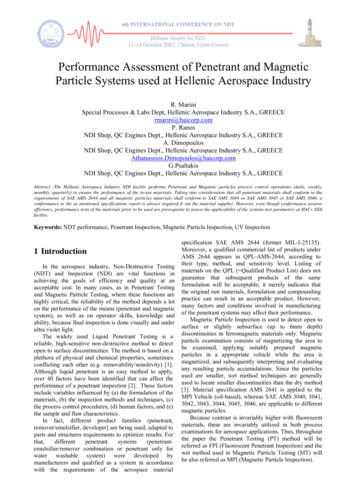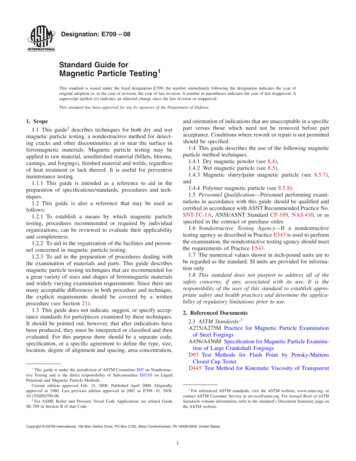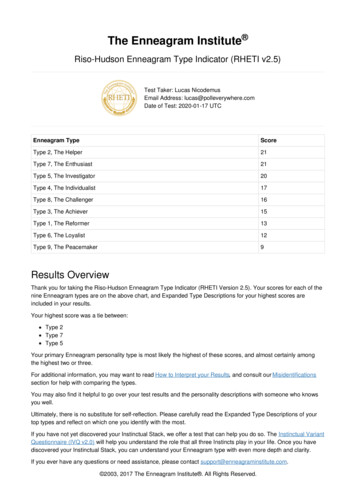
Transcription
The Enneagram Institute Riso-Hudson Enneagram Type Indicator (RHETI v2.5)Test Taker: Lucas NicodemusEmail Address: lucas@polleverywhere.comDate of Test: 2020-01-17 UTCEnneagram TypeScoreType 2, The Helper21Type 7, The Enthusiast21Type 5, The Investigator20Type 4, The Individualist17Type 8, The Challenger16Type 3, The Achiever15Type 1, The Reformer13Type 6, The Loyalist12Type 9, The Peacemaker9Results OverviewThank you for taking the Riso-Hudson Enneagram Type Indicator (RHETI Version 2.5). Your scores for each of thenine Enneagram types are on the above chart, and Expanded Type Descriptions for your highest scores areincluded in your results.Your highest score was a tie between:Type 2Type 7Type 5Your primary Enneagram personality type is most likely the highest of these scores, and almost certainly amongthe highest two or three.For additional information, you may want to read How to Interpret your Results, and consult our Misidentificationssection for help with comparing the types.You may also find it helpful to go over your test results and the personality descriptions with someone who knowsyou well.Ultimately, there is no substitute for self-reflection. Please carefully read the Expanded Type Descriptions of yourtop types and reflect on which one you identify with the most.If you have not yet discovered your Instinctual Stack, we offer a test that can help you do so. The Instinctual VariantQuestionnaire (IVQ v2.0) will help you understand the role that all three Instincts play in your life. Once you havediscovered your Instinctual Stack, you can understand your Enneagram type with even more depth and clarity.If you ever have any questions or need assistance, please contact support@enneagraminstitute.com. 2003, 2017 The Enneagram Institute . All Rights Reserved.
Best Wishes,The Enneagram Institute 3355 US Highway 209Stone Ridge, NY 12484Phone: (845) 687-9878Toll-free in the USA: (888) 366-3247Fax: (845) 687-7486Normal office hours Mon-Fri 9:00am - 4:00pm ETLimited email support at other times. 2003, 2017 The Enneagram Institute . All Rights Reserved.
Personality Type TWO: The HelperThe Caring, Interpersonal Type:Demonstrative, Generous, People-Pleasing, and PossessiveGenerally, Twos are caring, empathetic, warm, thoughtful, appreciative, generous,other-oriented, tactile, affectionate, well intentioned, and demonstrative.Twos get into conflicts by being people-pleasing, flattering, ingratiating, clingy,worried, possessive, insincere, seductive, self-important, and self-deceptive.At their best, Twos are encouraging, loving, self-nurturing, constant, joyous, humble,forgiving, gracious, and compassionate.Recognizing TwosType Two exemplifies the desire to feel loved, to connect with others in a heartfelt way, and to be a source ofbenevolence and love in our world. Twos are easily the most people-oriented of the Enneagram types. They focuson relationship and feel best about themselves when they are meaningfully engaged with others. They want toshare the good in their lives and genuinely enjoy supporting others with their attention and care. Insofar as theycan, Twos make good things happen for people. They will stay up late to take care of children or older folks, driveacross town to bring food, or see to it that others get medical treatment. When there is practical work to be done forothers, healthy Twos will be there, throwing themselves into the effort, heart and soul.Twos are genuinely interested in other people and in the details of their lives. They remember to send birthday andholiday cards long after their friends have moved away. They also remember your spouse's name and the names ofyour children and pets—plus who has which allergies and what their major was in college. Twos are the first in thekitchen after a party to help out with the cleanup. At the office, Twos have a bowl of candy or a tin of cookies attheir desk—not for themselves, but for anyone who drops by to chat. They are constantly thinking of others, andthey try to do nice things so that others will think well of them.Twos get into difficulty, however, when they begin to attend to others' needs without adequately dealing with theirown. They can get into denial about the extent of their own needs while insisting that their only concern is takingcare of others. At such times, Twos may develop "boundary problems." They disregard their own boundaries, doingthings for others that take them away from what they need to do for themselves, and they disregard the boundariesof others, doing things for others that they do not necessarily want done. When others feel crowded by the Twos'efforts to help, and try to set boundaries with them, Twos can feel hurt and insecure about the relationship and feelrejected.When Twos doubt that others want them, they redouble their efforts to win people over. They get caught up with"people pleasing" and ingratiating themselves with others, looking for things to do and say that will make people likethem. "Relating" with people becomes a full-time job: they are constantly making new friends while maintaining anetwork of old friends. Talking about "the relationship" with people becomes a habit, as Twos continually seekreassurance that their friendships and love-lives are secure and on track. 2003, 2017 The Enneagram Institute . All Rights Reserved.
They also begin to seek ways to make themselves more interesting and useful to others. Thus, they may pursuesuch interests as massage, psychic readings, energetic healing, nutrition, and other ways of being of service as away of making people feel good about themselves—and about having the Two in their life. They want to have aunique place in others' lives and to know privileged information about others that no one else knows. They wantothers to regard them as their "best friend," and to seek them out for personal advice, and to share special secretsand intimacies. They may begin to wear themselves out for others, giving unwanted advice and assistance, andbecoming "martyrs" to get attention and affection. When Twos go too far with this kind of behavior, however, itironically has the opposite effect on people—driving them away rather than creating stronger relationships.In brief, Twos want to feel loved, to have intimacy, to express their feelings for others, to be needed andappreciated, to be close to valued friends and family, to "rescue" potential friends and partners, to get others torespond to them, and to get and hold on to the love they want. Twos do not want to be out of touch with lovedones, to be in impersonal settings, to be left out of social situations, or to be in situations where there is nothing forthem to give.Their Hidden SideAlthough on the surface Twos appear to feel at ease with others and to be a source of emotional sustenance for thepeople in their lives, they also suffer from well-hidden feelings of rejection. Twos expect people to not want themaround, and they often feel that they need to be extraordinarily kind and supportive to get people to accept and lovethem. They usually try to conceal the depths of their loneliness or hurt beneath an image of concern for others,focusing on others' needs to help them feel better. Sometimes it does, but just as often, Twos may feel that othersare not appreciating them for their efforts, thus rekindling their feelings of rejection. Then they may become touchyor even openly angry, revealing the extent of the disappointment they are hiding.Relationship IssuesTwos are the Enneagram type most focused on relationships: people are where Twos focus their energies. Theyare generous with their time and attention and really want their loved ones to be happy and well-cared for.Problems develop, however, when Twos go overboard with their efforts to be close to their loved ones, often in thefollowing areas:Trying too hard to please the other—selling themselves out for affection and appreciation.Hovering around and not giving the other adequate space (usually caused by fears of imminentabandonment)Expecting "mind reading" from the partner and being disappointed when they fail to anticipate the Two'sdesires or needs.Becoming possessive of the partner and jealous of his or her spending time with others.Not acknowledging personal hurts, needs, and anger until they are becoming damaging to the relationship.Type CompatibilityTo learn more about compatibility issues and relationships with other types, see theEnneagram Type Combinations.The Passion: PrideTwos believe that they will be loved only if they are completely available to attend to the needs of others. To theextent that they succumb to this belief, they fear that others will reject them if they have needs or emotional hurts oftheir own. When Twos find themselves unable to acknowledge the extent of their emotional needs and desires, theyfall into the passion of pride. From this position, they feel duty-bound to care for others while denying that they haveany significant problems themselves. But of course, under the surface, Twos really do have many problems andlongings. Unfortunately, the more Twos deny their real emotional condition, the more they tend to expressthemselves to others with covert aggression, ulterior motives, and hidden neediness. This often leads to behaviorsthat unintentionally drive other people away. 2003, 2017 The Enneagram Institute . All Rights Reserved.
At Their BestHealthy Twos are sincere and warm-hearted, with immense good will and enormous generosity of spirit. They havean extraordinary ability to feel the feelings and needs of others. Because they are so empathetic, healthy Twosknow others' sorrows, and this motivates them to go out of their way to help and support people, especially in timesof need. They put a charitable interpretation on the behavior of others, emphasizing the good in people wheneverthey find it. But healthy Twos are able to maintain this generous approach to life because they are acknowledgingtheir own needs and, more importantly, addressing them.Healthy Twos do not wait around for a loving response from people in order to feel lovable. They recognize theirtrue strengths and limitations and accept them—extending the support and love to themselves that they wouldeasily offer to someone else. Thus, they are also able to accept others for who they are and relate to them on theirown level, whether the person is the president of a corporation, the mailman, or a delivery boy. Twos see thedignity and the humanity of people and respond to that. They also foster independence in others, nurturing selfconfidence, strength, and new skills so that people can grow on their own. They really want everyone to thrive anddo not want anyone to be dependent on them, physically or psychologically. They are sincerely encouraging andextremely appreciative of the talents and strengths they find everywhere. Healthy Twos let people know the goodthey see in them, a quality that is particularly helpful to those who may not see much good in themselves.Personality Dynamics & VariationsLearn more about the Directions of Integration (Security) and Disintegration (Stress).Under Stress (Two goes to average Eight)If Twos feel that their overtures of friendliness and many expressions of self-sacrifice are continually thwarted orignored, they may reach a point of stress in which they begin to openly express their anger in the manner ofaverage-to-unhealthy Eights. Their resentment at having been rejected by others (in perhaps subtle ways) reachesthe boiling point, and they simply cannot maintain their "loving attitude" any longer. Feeling that others are takingthem for granted makes the average Two suddenly act out in an average Eight manner, becoming ego-centric,controlling, and dominating, telling people what to do and when to do it. This kind of behavior puts Twos in thecenter of things and virtually forces others to pay attention to them. Bossing people around and being somewhatconfrontational can be surprisingly out of character for the Two. Under greater stress, it can be expressed inoutbursts of temper, aggressive confrontation, and threats of withdrawing support.Security (Two goes to average Four)With trusted others, or in situations in which Twos feel sure of themselves and their ability to be honest about theirfeelings, they may risk expressing their neediness and darker impulses. Rather than keep up the image of beingselfless and above feeling wounded by the ingratitude of others, they can become moody, self-absorbed, andtemperamental, revealing to intimates the true depth and extent of their emotional needs, self-doubts, anddisappointments—particularly with others. At such times, they can be extremely touchy—easily hurt by statementsthat others would see as harmless or even positive. They may also become more self-indulgent, giving themselves"goodies" that are not very good for them as a way of compensating for all of the sacrifices they feel they have beenmaking for others.Integration (Two goes to healthy Four)Integrating Twos become aware of how much they have denied their needs and their darker feelings-and how 2003, 2017 The Enneagram Institute . All Rights Reserved.
much they have deceived themselves about their motives. At Four, they begin to accept themselves morecompletely—not rejecting any aspect of themselves they find. Even their destructive feelings toward others can beheld compassionately. They are more honest with themselves (after the manner of a healthy Four) and discoverhumor and humanity in whatever feelings and impulses they have. This gives Twos the ability to see themselvesobjectively and without shame—and with love and balance. They are also able to support others from the fullnessof who they really are and to have greater intimacy with them because integrating Twos are more intimate withthemselves. Gradually and naturally, they become more authentic, expressive, sensitive, and creative in ways thatare enriching to themselves and other
Riso-Hudson Enneagram Type Indicator (RHETI v2.5) Test Taker: Lucas Nicodemus Email Address: lucas@polleverywhere.com Date of Test: 2020-01-17 UTC Results Overview Thank you for taking the Riso-Hudson Enneagram Type Indicator (RHETI Version 2.5). Your scores for each of the nine Enneagram types are on the above chart, and Expanded Type Descriptions for your highest scores
